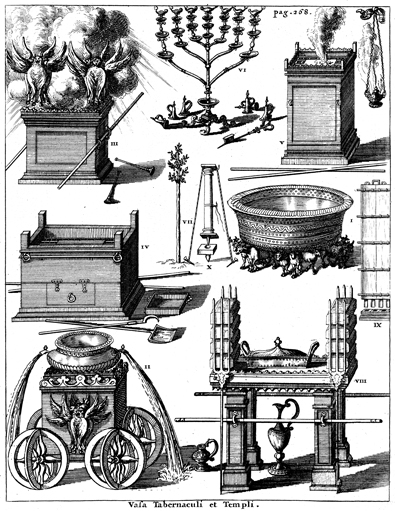Tabernacle and Temple
Author: Leusden, Johannes, 1624-1699.
Image Title: Tabernacle and Temple
Scripture Reference:
- 1 Kings 7 (further images / scripture text)
- 2 Chronicles 4 (further images / scripture text)
- Exodus 25 (further images / scripture text)
- 1 Samuel 2 (further images / scripture text)
- Leviticus 7 (further images / scripture text)
- Exodus 30 (further images / scripture text)
- Leviticus 24 (further images / scripture text)
- Hebrews 9 (further images / scripture text)
- Numbers 17 (further images / scripture text)
Description: This image, titled VASA TABERNACULI ET TEMPLI, or “the Tabernacle and the Temple,” catalogs images of structures and features associated with YHWH’s earthy dwelling place or residence in ancient Israel. Image I depicts the “Sea,” a metal basin of water for priests to wash themselves in supported by 12 bronze oxen in sets of three facing each direction as prescribed in 1 Kings 7:23-26 and 2 Chronicles 4:2-5. Image II shows one of the ten bronze wheeled stands and water basins used for rinsing off what would be used for burnt offerings, dictated by 1 Kings 7:27-38 and 2 Chronicles 4:6. Faucets on either side of the basin release the water onto the ground. A fantastical amalgam of a lion, bull, and cherubim is hammered onto the side panels. Image III illustrates the Ark of the Covenant as described in Exodus 25:10-22. The ark is constructed of acacia wood with gold overlay, and four gold rings allow it to be transported by inserting a pole on either side. Flanking the mercy seat made of gold on the top center are two golden cherubim with open wings amidst a cloud of smoke. Two trumpets, possibly shofars, lie beside the ark. Image IV depicts the altar for burnt offerings, also called the Brazen Altar, bronze altar, or altar of sacrifice, which stood in the outer courtyard of the temple or tabernacle complex with its transporting poles removed. The altar’s base is a hollow acacia wood box overlaid with bronze with an inner bronze grating used for burning animal sacrifices. Four horns project from the top of each corner, and one shovel, hook tool, and tray are scattered beside the altar. Image V depicts the altar of incense, which sat in front of the curtain on the east side of the inner throne room that separated the Most Holy Place from the Holy of Holies. This altar is smaller than the Brazen Altar, made of acacia wood and overlaid with pure gold, and two gold rings allowed two poles on either side to transport it. Four horns protrude from the four corners of the altar, which were used annually for the blood of atonement sin offering ritual. Priests burned incense every morning and evening as prescribed by Exodus 30. Beside the altar is a thurible, or a metal censer, suspended from chains in which incense was burned for rituals and religious ceremonies. Image VI illustrates a menorah, also known as a candelabrum or lampstand, ten of which occupied the Temple before the inner sanctuary. The menorah is a single piece of hammered gold with six branches decorated with blossoms, leaves, and petals, and is accompanied by five small lamps, although seven are prescribed in Exodus 25:31-40. Image VII depicts Aaron’s staff or rod that budded, which was stored inside the Ark of the Covenant according to Hebrews 9:4. Aaron’s rod along with Moses’ staff was endowed with miraculous power which was demonstrated during the plagues in Egypt. In order to resolve the Korah rebellion against the priesthood in Numbers 17, God commands that each of the Twelve Tribes provide a rod and declares that the rod of the tribe chosen to become priests will miraculously sprout overnight. Aaron’s rod represents the Tribe of Levi, and "it put forth buds, produced blossoms, and bore ripe almonds" overnight (Numbers 17:8), evidencing the Levite’s exclusive right to the priesthood. Image VIII depicts the table of shewbread also referred to as the”table of the presence.” This table stood inside the Holy Place on the west side and was made of acacia wood overlaid with pure gold as dictated in Exodus 25:23-30. The table has four legs, and two gold plated poles which are inserted through golden rings attached to the legs for transporting. The table’s purpose was to hold 12 cakes of bread made of fine flour placed in two rows of six, each loaf representing one of the tribes of Israel (Lev. 24:8). Vessels of pure gold were typically on or around the table, including dishes to plate bread, pans or spoons to sprinkle frankincense, pitchers for liquid offerings, and bowls containing the frankincense. On each corner is a three pronged fork or flesh hook used to rearrange sacrifice, remove or add coals to the fire, or transport incense according to 1 Samuel 2:13 .
Click here for additional images available from this book.
Request a high-resolution file (fees apply)
Rights Statement: The online edition of this work in the public domain, i.e., not protected by copyright, has been produced by Pitts Theology Library, Emory University.
Rights Status: No Copyright - United States
Pitts Theology Library provides copyright information as a courtesy and makes no representation about copyright or other legal status of materials in the Digital Image Archive.

